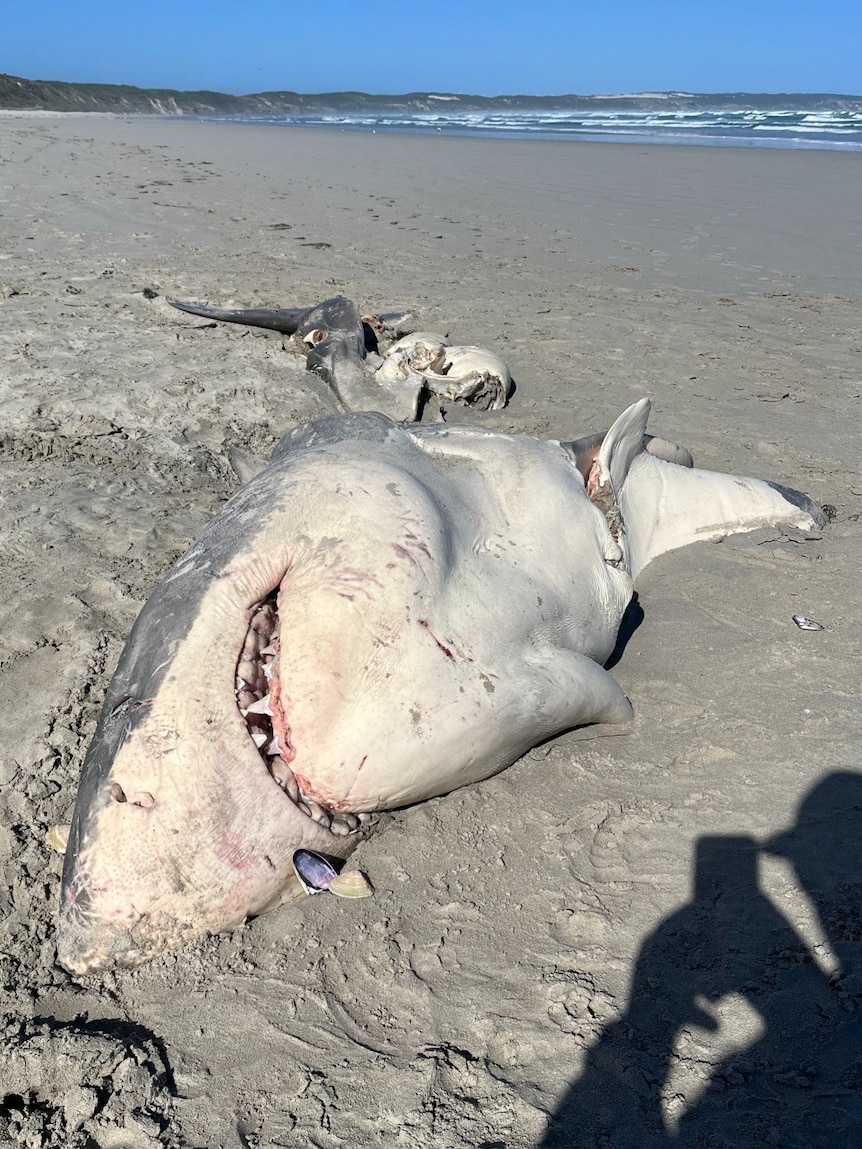A great white shark that washed up dead on a beach in Victoria’s southwest was probably ripped apart by a pod of killer whales, according to witnesses and a researcher.
Key points:
- Just nine interactions between orcas and great whites have been recorded in Australia and New Zealand
- Killer whales are known to rip open other animals to eat internal organs
- Research is being conducted to understand interactions between sharks and orcas
The carcass looked like it had been ripped in half when it was found by residents near Cape Bridgewater, west of Portland.
Fisherman and bait shop manager, Ben Johnstone, estimated the shark was about 3 metres when he inspected the remains on Tuesday after receiving a tip-off.
The apparent injuries to the shark made him suspect orcas were responsible.
Two days prior a pod of killer whales had also been seen circling in the bay by nature photographer Allen McCauley.
“They are known in other parts of the world to attack, and they go for the livers,” Mr Johnstone said.
The grisly find comes after a shark attack on a swimmer at Beachport earlier this month and a great white sighting by tuna fishers off the coast of Cape Jaffa, both just over the border in south-eastern South Australia.
Orcas notoriously ‘picky eaters’
After being reported to authorities, the carcass was collected, and information and samples were sent to government agencies and academics.
Flinders University trophic ecologist Lauren Meyer said while it was not “100 per cent clear”, it was likely a killer whale had attacked the shark to “slurp out” its liver.
“We’re not actually sure why killer whales are such picky eaters,” Dr Meyer said.
“We see this with things like humpback whales, where [killer whales] come in and actually eat the tongue and leave the rest of the whale.
“We certainly see that they prefer the liver of white sharks, mako sharks, bronze whalers and sevengills, and even tiger sharks.
“We also see they like to eat the intestines of sunfish, which is really strange, and dugong intestines.”
Dr Meyer said nine interactions with orcas and great whites had been reported in Australia and New Zealand, with other incidents occurring in South Africa and the United States.
“I’m not surprised to see this in a place like Portland,” she said.
“We know there are white sharks that go through that area and use it as an important corridor.
“We also know that it’s a place for killer whales where they hunt a number of different prey items.”
‘Pretty cool’ sight for fishers
Mr Johnstone said while great whites and killer whales were reasonably common in the area, he had not seen a shark carcass washed up during his 15 years fishing in the area.
“It’s probably a once in a lifetime experience to see something like that,” he said.
“Every now and then [a killer whale] will grab a tuna off of some poor anglers’ line.”
Mr Johnstone shared images of the shark on his business’ Facebook page.
The post attracted hundreds of reactions and comments, and dozens of shares.
“[People said] it’s cool and terrifying,” he said.
“Mother Nature at her best … and most devastating.”
Elusive and mysterious species
Dr Meyer and the research team at Flinders was part of an international team creating a database on interactions between sharks and killer whales to “unpack” what was happening globally.
“Killer whales are such mysterious animals because we don’t interact with them very often,” she said.
“They’re relatively elusive and each different pod and ecotype has such specific behaviour that it’s hard to draw conclusions across all of killer whales because they all act so differently.”
Dr Meyer said researchers would continue to investigate the Portland incident, looking into rake marks and leftover genetics including saliva.
Posted , updated




